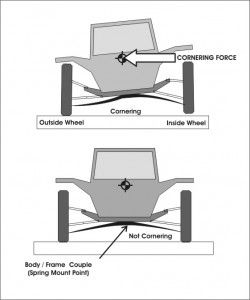Springs & Shocks – Important Concepts
Springs & Shocks
When setting up your car for better handling springs and shocks are a natural choice to quickly improve the ability to corner harder, with less lean and sway. Here are a few basic definitions and some examples to help you understand the components and make choices.
Springs: Springs are for the most part linear mechanical devices (although there are non-linear springs like variable rate springs that we will not cover here).
Linear springs: For every increment of compression or extension from the resting length, a predictable force is produced. They are manufactured in a variety of form factors like coil, leaf, mono-leaf, torsion etc.
Spring Types: Two principal types of spring are used in most cars, they are leaf and coil. The leaf spring acts like a simply supported beam in loading while a coil spring is mostly torsional loading.
Spring rate: The amount of force exerted by a spring as it is compressed, extended or rotated depending on the type.
EXAMPLE: A coil spring with a spring rate of 200 inch/pounds will exert 200 lbs of force for the first inch it is compressed, 400 lbs of force if compressed two inches, 600 lbs of force if compressed three inches and so on until the spring coils are touching (fully compressed).
IMPORTANT CONCEPT No.1
This spring force is irrespective of how fast the spring is compressed. The spring force is independent of time.
Coil vs Leaf
The purpose of an independent suspension is independence of motion for road / track conditions. When a spring element ties the two sides together you loose some of that independence. There is some coupling side to side in transverse mounted springs so when you introduce body roll, as in cornering, both ends are loaded but the wheel on the outside of the corner tends to load more than it should because of the couple to the body / frame rolling moment. The same is true on the inside wheel only that wheel experiences unloading due to the same coupling. Now consider an independent coil spring which has no such body / frame coupling. It will still be loaded on the outside and unloaded on the inside, but there is no added body roll coupling through the mount since the spring does not have a frame mount point. This is true of both front and rear leaf springs.

The same event occurs when you hit a bump. There is coupling where there should not be coupling and it impacts handling. It’s as though you have a solid axel with one wheel affecting the other negatively.
NOTE: Mono-leaf springs are just another type of leaf spring with an important difference; damping. A multi-leaf spring is made of a stack of leaf elements which move against each other when loaded. The friction of their movement helps to damp the spring. A mono-leaf has no such damping so the spring tends to be more “bouncy” requiring more shock damping than the multi-leaf spring of the same rate and size. They still have the inherent body / frame coupling disadvantage of leaf springs.
A coil spring allows truly independent action of the suspension. In addition to this the spring rate can be adjusted separately to balance the car. This is one of the big reasons that the coil over spring and shock combination is so good. It gives the ability to easily and quickly adjust the height and load of a given wheel independent of other wheels.
Coil springs allow for true independence of action for both cornering and bumps.
Shock Absorber: A mechanical device to damp, or slow motion. It does this by absorbing energy which it converts into heat in the case of a hydraulic shock absorber found in a car.
IMPORTANT CONCEPT No. 2
A shock absorber in combination with a spring affects how quickly a spring will compress and rebound. Shock absorbers have a damping rate that is dependent on time.
CHANGING THE DAMPING RATE (LIKE STIFFER SHOCKS) WILL NOT AFFECT THE SPRING RATE.
It is very important to understand that the shock rates of a given spring are set to work with the spring rates and the weight of the car. The damping (shock) rates are then tuned, or adjusted, to a somewhat subjective compromise between sport and casual driving for the given spring rate. This means that a major change in spring rates REQUIRES a change in the shock valving. This is the principal advantage of adjustable shocks.
EXAMPLE: Different springs will give you a stiffer or softer suspension, but shock adjustment can affect that ride. If you go cruising into a long corner, the stiffer your springs are, the less body roll (leaning) you will get. The softer the springs are, the more body roll you will get. The valving of the shocks will determine how fast you get to that maximum roll point.
Next Steps
Now that you know some fundamental concepts it’s time to select the products to improve the handling of your car.
-
The Shark BiteTM front and rear coil over kits for Corvettes are an ideal way to achieve both a higher spring rate, better shock damping, and true independent suspension.
-
For Mustangs we have the Vector Series coil overs or a complete stage kit.